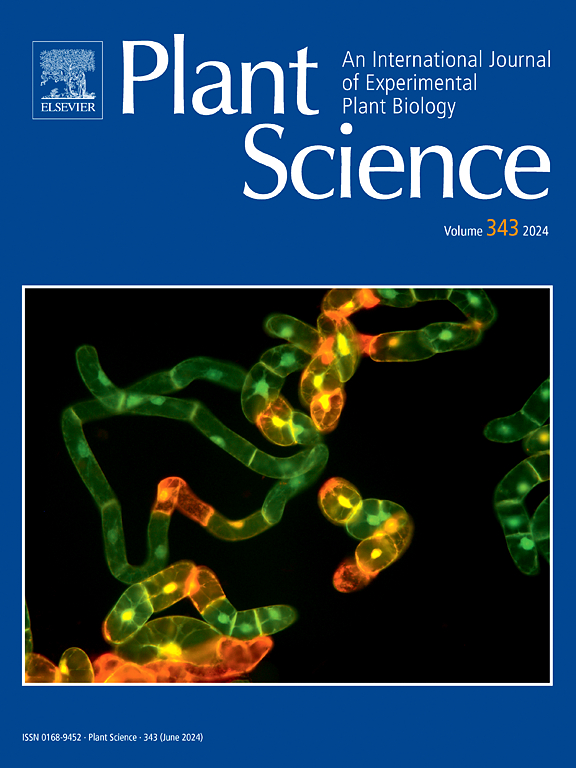The role of ribosomal protein StRPS5 in mediating resistance of Solanum tuberosum plants to Phytophthora infestans
IF 4.2
2区 生物学
Q2 BIOCHEMISTRY & MOLECULAR BIOLOGY
引用次数: 0
Abstract
Potato late blight caused by Phytophthora infestans is a devastating disease in potato production. Effectors secreted by P. infestans can target plant proteins and disrupt plant immune responses. The research on plant target proteins has mainly focused on ubiquitination, immune-related proteases, MAPK signal transduction pathways, and transcription factors. The question of whether plants possess novel disease resistance-related proteins or pathways remains unanswered. In this study, we identified a potato ribosomal protein, StRPS5, as a target of the P. infestans RxLR effector, Pi16275. Subcellular co-localization of StRPS5 and Pi16275 was observed in the nucleus, cytoplasm and cell membrane of Nicotiana benthamiana. The expression of StRPS5 was induced and up-regulated in the early stage of P. infestans infection. Furthermore, transient overexpression of StRPS5 in tobacco leaves was observed to inhibit the infection. We also observed a significant accumulation of H2O2 at the site of StRPS5 overexpression, indicating a role of StRPS5 in promoting the outbreak of reactive oxygen species (ROS) burst after pathogen infection. Silencing of StRPS5 in potato exhibited a marked increase in susceptibility towards P. infestans, whereas overexpression of the gene led to an enhancement of disease resistance. As ROS are key signaling molecules in plant immune responses against pathogens, we investigated flg22-triggered ROS accumulation in transgenic potatoes and the results showed that ROS accumulation in StRPS5-silenced leaves was significantly depressed, while the accumulation was increased in StRPS5-overexpressing leaves. Collectively, our findings demonstrate that potato ribosomal protein StRPS5 serves as a target for the P. infestans effector Pi16275 and that StRPS5 positively regulates potato resistance to P. infestans by increasing the accumulation of ROS.
核糖体蛋白StRPS5在介导龙葵对疫霉抗性中的作用
马铃薯晚疫病是马铃薯生产中的一种毁灭性病害。病原菌分泌的效应物可以靶向植物蛋白,破坏植物免疫应答。对植物靶蛋白的研究主要集中在泛素化、免疫相关蛋白酶、MAPK信号转导途径、转录因子等方面。植物是否拥有新的抗病相关蛋白或途径的问题仍然没有答案。在这项研究中,我们确定了马铃薯核糖体蛋白StRPS5作为P. infestans RxLR效应物Pi16275的靶标。StRPS5和Pi16275在烟叶细胞核、细胞质和细胞膜中亚细胞共定位。StRPS5在感染早期被诱导表达并上调。此外,烟草叶片中短暂过表达StRPS5可抑制侵染。我们还在StRPS5过表达位点观察到H2O2的显著积累,这表明StRPS5在病原体感染后促进活性氧(ROS)爆发的作用。在马铃薯中,StRPS5基因的沉默显著增加了马铃薯对病原菌的易感性,而该基因的过表达则增强了马铃薯的抗病能力。由于ROS是植物免疫应答病原菌的关键信号分子,我们研究了flg22在转基因马铃薯中引发的ROS积累,结果表明,strps5沉默叶片的ROS积累显著降低,而strps5过表达叶片的ROS积累增加。总的来说,我们的研究结果表明,马铃薯核糖体蛋白StRPS5可以作为P. infestans效应物Pi16275的靶标,并且StRPS5通过增加ROS的积累积极调节马铃薯对P. infestans的抗性。
本文章由计算机程序翻译,如有差异,请以英文原文为准。
求助全文
约1分钟内获得全文
求助全文
来源期刊

Plant Science
生物-生化与分子生物学
CiteScore
9.10
自引率
1.90%
发文量
322
审稿时长
33 days
期刊介绍:
Plant Science will publish in the minimum of time, research manuscripts as well as commissioned reviews and commentaries recommended by its referees in all areas of experimental plant biology with emphasis in the broad areas of genomics, proteomics, biochemistry (including enzymology), physiology, cell biology, development, genetics, functional plant breeding, systems biology and the interaction of plants with the environment.
Manuscripts for full consideration should be written concisely and essentially as a final report. The main criterion for publication is that the manuscript must contain original and significant insights that lead to a better understanding of fundamental plant biology. Papers centering on plant cell culture should be of interest to a wide audience and methods employed result in a substantial improvement over existing established techniques and approaches. Methods papers are welcome only when the technique(s) described is novel or provides a major advancement of established protocols.
 求助内容:
求助内容: 应助结果提醒方式:
应助结果提醒方式:


